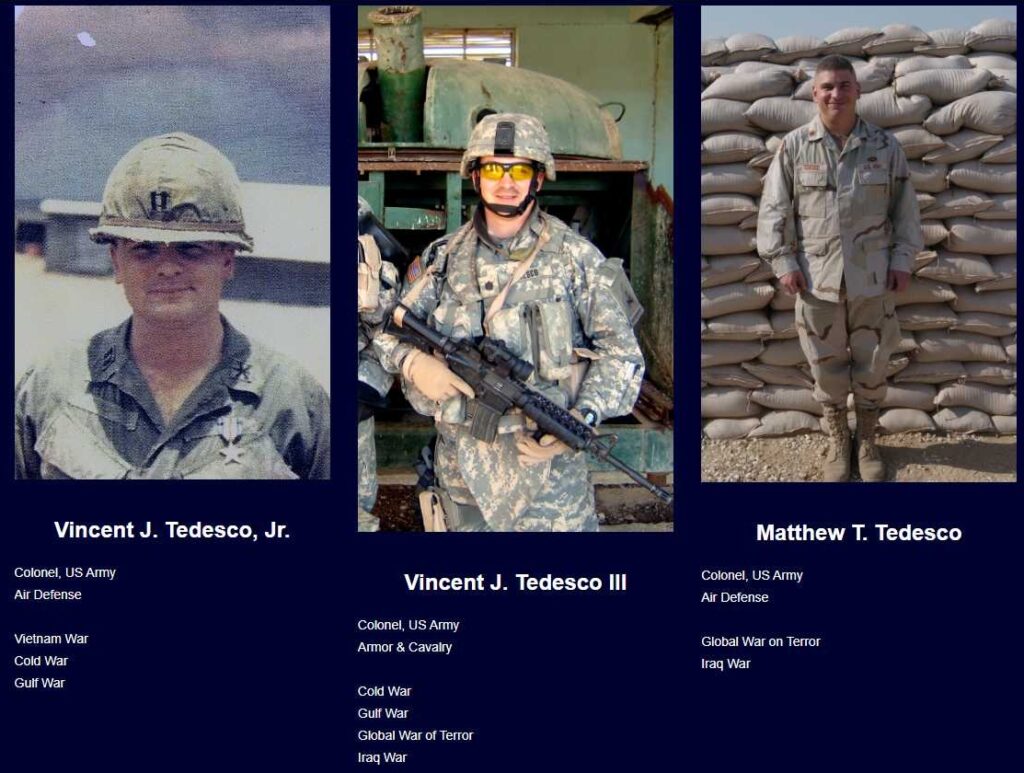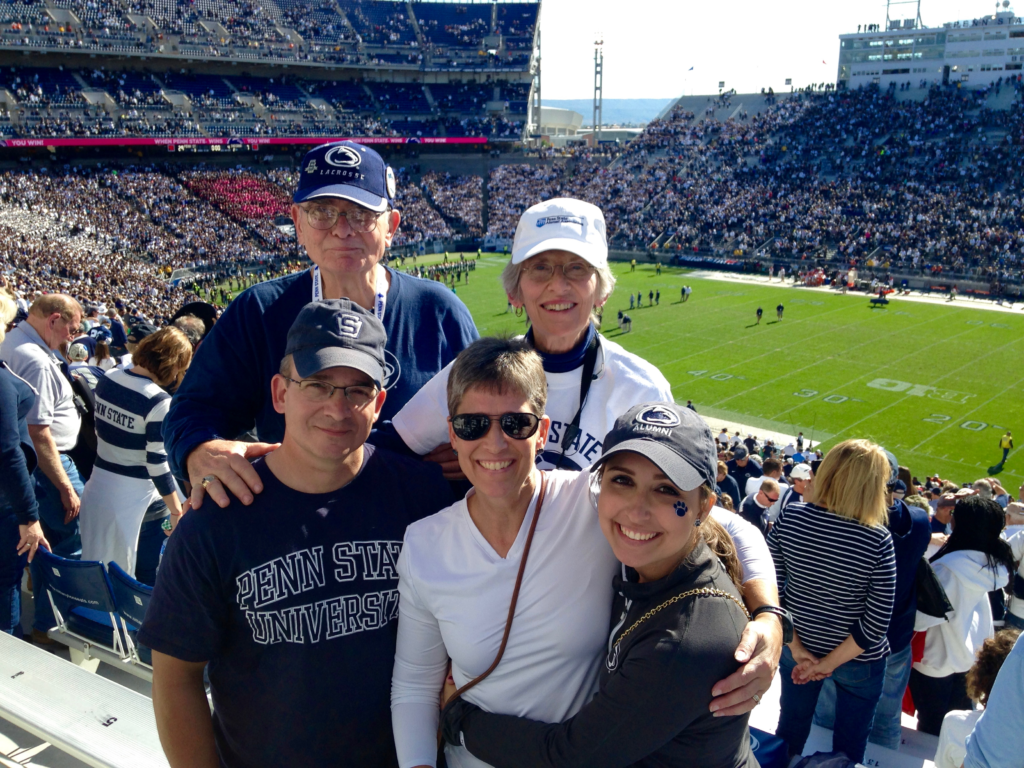
“Every minute you spend with these guys is priceless. How can you not love being amongst them. You see them as they were. You start laughing to see them as they are. But more than anything else, you’re happy to see them and to once again share that brotherhood that will never go away.” Vincent J. Tedesco
This scrapbook is an attempt to assemble a collection of material in tribute to a great warrior and leader before it and all of our stories are lost to time. I will do my best to get at least some of his story organized and published on the NDQSA.COM website as part of our National Dusters, Quads & Searchlights Association heritage preservation. In my mind, the quote above captures why that heritage is worth sharing with future generations. The Vince Tedesco scrapbook is structured to encompass links to source material and in many cases archived copies of that original, so they are not lost if the source internet link breaks. Richard Burmood, Editor
To quickly understand Vince Tedesco we can read his own words from two speeches given at National Dusters, Quads & Searchlights Association reunions.
Lessons I Have Learned, NDQSA Reunion, Savannah, Georgia. July 9, 2010
Sample: Lessons of the Nation – “The service people who went and did their duty didn’t pick what they had to go do.
They just did it, and I think the nation has gotten that lesson loud and clear. You’re the ones to thank, and you helped the Nation learn that lesson.”
Tedesco Speech 7-9-2010 lessons I have learned
The Love That I Have For You, NDQSA Reunion, Cleveland, Ohio. July 1, 2023
Colonel Vincent Tedesco addresses members and families of the NDQSA.
In the speech, he addresses John “Tank” Huelsenbeck who was one of the founders of NDQSA.
Sample: “We gave the branch a wonderful beginning.
We learned to love and lead those we had been around.
I learned a lot commanding you guys.”
“We are a band of brothers that love each other.”
Col. (Ret.) Vincent J. Tedesco, Jr., was born in Jamaica, NY, January 29, 1943. His parents were Vincent James Tedesco, Sr. and Angela Agnes (Letterelo) Tedesco. Vincent, Sr. came to the United States in February 1921. Vincent, Jr. had one brother, Michael Thomas Tedesco.
Tedesco attended Pennsylvania State University (Penn State) in the early 1960s and earned his Bachelor of Science in Accounting. On campus Vincent was a member of Delta Upsilon Fraternity. He was the starting goalie and co-captain of the Penn State lacrosse team. Vince was selected as one of the outstanding freshmen athletes and was All League and All Conference.
He was a member of the Penn State ROTC program. He later described it as a lot of marching but fortunately for him a lot of leadership training. The lesson he learned and applied throughout his life was the 3M principle: The men came first – then the mission – and the last I take care of is me.
Vince met Suzann, a young home economics student while at Penn State. They were married in the chapel on campus.
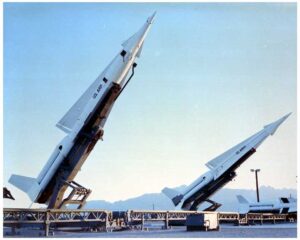
Commissioned into the Artillery branch in 1964, he was trained in the Nike Hercules missile system.
This was before there was a separate Air Defense Artillery branch.
Vince and Suzann’s early duty tours included Germany and the U.S. but he knew he would go to Vietnam.
By 1967, he was on his way after promotion to captain.
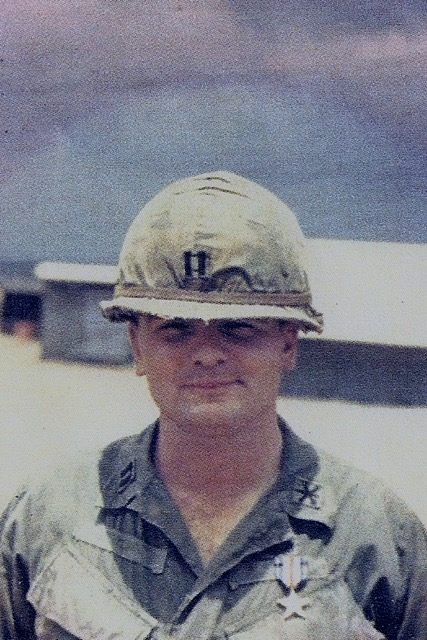
Captain Tedesco was assigned as a staff officer to the 1st Battalion, 44th Artillery. The battalion was operating in I Corps in support of the Marines north of Da Nang along the Demilitarized Zone (DMZ) with its headquarters located at Dong Ha. C/1/44, with its M42 Dusters, bolstered Marine firepower at Camp Carroll and furnished road security for convoys along Route 9 which ran from Dong Ha to Khe Sahn. On January 24, 1968, a resupply convoy traveling from Dong Ha to camp Carroll along Route 9, known as “Ambush Alley”, came under attack by enemy forces. Tedesco commanded the reaction force sent from Dong Ha to save the Soldiers and Marines trapped in the ambush. It was not Tedesco’s job to take out the Dong Ha Quick Reaction Force, but the normal Reaction Force Commander, Captain Fredrick Taylor, was on another battalion mission. Captain Tedesco, without hesitation, took control of the Reaction Force. Quickly, he assembled a full complement of Dusters, Quad 50 Machine Gun Trucks, and 1/44 Army personnel then proceeded to the ambushed convoy. When he arrived, he found a scene of chaos. He rallied the combat capable soldiers and organized a defense in time to save the Soldiers and Marines trapped in the ambush, get the wounded out of danger, recover the fallen and secure the site. That night he could not fall asleep, so decided to describe the action in a tape recording made for his wife Suzann. This recording preserved what the mind and time would have readily blurred and provides the factual basis of Tedesco’s account of that day.
Source: OUTNUMBERED ON THE DMZ SAVING CAMP J.J. CARROLL
24 hours of face-to-face, hand-to-hand fighting against 12,000 enemy soldiers a small contingent of Dustermen and Marines turn the tide of battle.
Written by Joseph M. Belardo, Sr. with the support of Colonel (retired) Vincent J. Tedesco, US Army pages 67-74
https://ndqsa.com/wp-content/uploads/2024/02/DQS_S-Belardo-Story-saving-camp-Carroll.pdf
Meanwhile, while this battle raged, Captain Vincent. J. Tedesco, the 1st/44th Artillery Liaison Officer, was in the officer’s club at Dong Ha drinking a cold beer, unaware that one of his combat batteries was in a hellacious firefight on Route 9 below Camp J.J. Carroll. Word came that Charlie Battery and their Marine Reaction Force, trying to rescue an overrun convoy, was in very deep contact with the NVA and needed help. It wasn’t Tedesco’s job to take out the Dong Ha Reaction Force, but normal Reaction Force Commander Captain Fredrick Taylor was on another battalion mission. Captain Tedesco, without hesitation, took control of the Reaction Force. Quickly, he assembled a full complement of Dusters, Quad 50 Machine Gun Trucks, and 1st/44th Army personnel then proceeded to the ambushed convoy.
Captain Vincent J. Tedesco:
That evening I could not fall asleep, I decided to describe the action in a tape recording made for my wife Suzann:
I don’t know where to start to tell you, Suzann, about what happened yesterday or should I say last night. I guess I’ll start from the beginning. I was over in the club around a quarter to five when we got word that Charlie Battery was in contact with the enemy on Route 9 between Cam Lo and Camp Carroll. They had gone to retrieve a convoy that had been ambushed on that road, and they were in deep contact. They needed help and Fred Taylor wasn’t around. He is the Reaction Force Commander; I’m the alternate Commander. Since he wasn’t around, it was my job to take the Reaction Force in there and try to bail out Charlie Battery. We left Dong Ha about 1730, and it took us a half hour to get to the ambush site.
I had two Dusters and two Quads 50s with me. I was in the lead Duster, the Quads were in the middle, and one Duster in back. When we approached the ambush site, I saw a tank off to the side of the road. Apparently knocked out of action, it was abandoned. I saw a dead Marine lying on the front of the Tank. Later, I found out he was the officer in charge. There were trucks and a jeep in the convoy, every one of them knocked out. The jeep had been knocked out by an RPG, which is similar to our bazooka or 3.5 rocket launcher. Those still alive were hiding against the vehicles and along the sides of the road, not doing anything very much but looking very horrible and scared and frightened. I saw, further up the road across a little bridge, Charlie Battery’s Duster. The guns pointed crazily up at the sky, the hatch in front was open and nobody was visible around the track.
I took my track, and we drove past the tank and proceeded toward Charlie Battery’s track trying to find out what the story was with them and to give them any support we could. As we started moving along the road, we had to pull way off the road into the bushes because there were so many wounded and dead along the road. We had to drag the wounded and dead off the road before we could move forward. The enemy was constantly shooting at us. We finally could move back on the road and crossed the bridge. I moved my Duster off the road to my right and saw where the enemy fire was coming from. We were receiving sniper fire, and the Air Force was putting air strikes into the area.
I directed the track commander, SSgt. Vincent DeSantis, to return the fire on the enemy that was raking our relief column. With DeSantis directing fire and loading the guns, their Duster delivered effective fire against the NVA automatic weapons, recoilless rifles and mortar positions in the surrounding hills. I left my track and ran to Charlie Battery’s track. I started looking for an officer or NCO in charge, hoping to find out what had happened. I found Lt. Steve Hardin and discovered three of Hardin’s five-man crew had been wounded when RPGs had slammed into the track. Spec. 4 Gilbert had both arms blown off by the first RPG. The second RPG had blown off the muscles, tendons and flesh from the back of Pvt. Solomon’s legs. Marines who had been riding on Duster were also wounded. Nearby, a Marine Lieutenant Terry Joeckel, who could not speak because his lower jaw had been shot away, was calmly writing down grid coordinates on a piece of paper. He passed the piece of paper to his radio operator, who called in the fire mission.
Suzann, it was horrible. People dead and wounded were all over the place and in a complete state of shock. It was impossible to set up security or try to get the convoy functioning. I got on the horn and notified command what the situation was and that we needed infantry and choppers. Running in a low crouch, I crossed the road and re-crossed the bridge and made my way to the destroyed convoy. I passed the main body of destroyed trucks, past the knocked-out Tank to where I had left the two Bravo Battery Dusters and G65 Quad 50’s and the rear Duster. They directed their fire on either side of the road, at the same place the infantry were placing their fire and where the snipers bullets were coming from. Satisfied their rounds were on target, I moved back down the line, trying to find any officer in charge of the convoy. There were two officers, a Marine Captain and an Army Lieutenant present. All they could do was hide up against the track vehicles. There were wounded all over the place. Suzann, it was horrible. There was a wounded Warrant Officer in a very complete state of shock. It was impossible to get them to move off the road, set up some security, and try to get the convoy functioning.
When I saw these two officers weren’t very willing or capable of taking command, I took command of the entire destroyed convoy. My first problem was to get the wounded out. I got on the horn and notified Carroll what the situation was, and that we needed infantry security and choppers to evacuate the wounded. The NVA now concentrated their fire on the Bravo lead Duster, seriously wounding DeSantis in the back. Refusing medical aid, he continued to direct his crew’s fire and load the guns. Another RPG struck the rear of the turret, killing one of the Cannoneers, Spec. 4 Billy Strickland, and wounding the rest of the crew. Wounded a second time, DeSantis continued to refuse medical aid, the bullets showering all around him. He began evacuating casualties from the stricken vehicle.
Staff Sgt. Vincent DeSantis: I was part of “B” Battery, 1st Bn/ 44th ADA and our battery was located across the road from the 1/44th ADA Battalion Headquarters at Dong Ha. It’s a bit after 3 PM and my crew and I were in the motor pool doing maintenance, just trying to get through the end of the work day. My Platoon Sergeant ran up to us and told us there was a fire-fight down the road and to get my track to the main gate and wait for the rest of the reaction force to form. My track was the first track to arrive at the gate so we became the lead track in the reaction force. It normally takes six men to properly man a Duster, at that moment my crew complement was: me, SSgt. Vincent DeSantis as Squad leader. My Driver was James Carr, the Gunner was William Swartz, but I still can’t remember the name of the azimuth tracker. I would usually be the right gun loader, but at that moment we did not have anyone hitting Dong Ha Mountain to our far right. For whatever reason my track slowly preceded into what seemed like the center of this massive ambush. We pulled off the road into a small clearing and Captain Tedesco advised us that he would proceed on foot to access the situation and see if there were any survivors. As soon as he left we began to take enemy fire. I felt a sting in my back and realized I was hit by a sniper round. I directed Strickland to man the M-60 machinegun and to fire into the wood line. My idea was with Strickland firing the machine gun into the tree line to protect us; the azimuth gunner and I could load the 40MM and get the guns back into action. I was about to direct the azimuth guy to rotate the tub around when an RPG hit the gun tub just above the Driver’s position. The explosion was deafening. A bright light and the fire ball filled the tub. I felt the heat of the fire ball on my arms. After the fire ball burned out, I checked myself to see if I was in one piece. There was no panic from the gun crew. I called out to the crew, the gunner Swartz said he was ok, the azimuth tracker said he was ok. I looked across to Strickland, he was sitting on his loader seat very still, and his head was down. I reached over to him said his name and shook him twice… he was dead. Now unable to man the guns, those of us able to move left the track and returned to the road and back east out of the kill zone. To this day, not a day goes by that I do not think of Billy Strickland. God bless him.
Captain Vincent J. Tedesco:
I moved back to my track trying to find out why my Duster wasn’t firing. The Duster Squad Leader told me they had been hit. I ran around to the front of the track to get to the radio and let them know we had lost another track, and I saw a horrible sight. My Driver, Spec. 4 Can, who had driven me into the ambush with his head sticking out of the hatch, was hit in the face and head when an RPG or aerial bomb landed near our track. It blew shrapnel and debris all over his face, shoulders and neck. I thought he was dead. He’s in critical condition, but I think he might pull through. As of now, he’s still alive. The radio was out of action and everything was covered with blood. I was now trying to give and get medical aid for him, Sergeant DeSantis, and everyone else. I moved back across to Hardin’s track again, trying to get some kind of aid for all the wounded. Each time I ran back and forth trying to give aid and reorganize the men, there were more and more wounded and killed. Finally, a medivacs chopper came in, and then we started receiving even more automatic fire and RPG’s. All the enemy now concentrated their fire on the approaching chopper as he tried to land. I ran over to the chopper and got him out of the area before he got shot down in the middle of the convoy. This went on and on and on, Suzann, just on and on and on. I kept moving up and down the convoy, kept calling for infantry and artillery. As it started getting darker, I called for illumination. The illumination rounds bursting high overhead, released parachute flares that bathed the terrain in an eerie orange glow. I knew the NVA would use the cover of darkness to move in for the final kill. I just kept calling for illumination as we waited for reinforcements and another Reaction Force.
Finally, after waiting for hours for help, I decided we were going to load all the wounded on the two Quad 50 trucks and the tracks and make a run for it. We had gotten one of the Quads loaded with the wounded when two Seabee trucks came in on their own to give us help. We got some more wounded and some dead loaded on their trucks. They headed out under the protection of the Quads. All of a sudden, the choppers started coming in. The choppers started landing all around us, taking out the other wounded. Now that the wounded were leaving, my new concern was the tracks and trucks that were out of action. For some unknown reason there were at least 50 civilians huddled in the area. We fired over their heads to keep them down. We weren’t sure whether they were VC – NVA or what they were doing. We had a Marine sergeant covering them the whole time with a machine gun.
Hardin and I returned with a few Marines to secure our Dusters. I didn’t want to leave the destroyed tracks for the NVA. I requested permission to destroy the Dusters, and Battalion denied this permission. They said a relief column from Dong Ha was on its way. A third Reaction Force commanded by Captain Charles Vickers, the 1st/44th Artillery S-4, departed Dong Ha and headed to the ambush site at full speed. They consisted of two Dusters from Alpha Battery, two G65 Quad 50s, and four ammunition-laden five-ton trucks carrying 1st/44th Headquarters Battery clerks, cooks, drivers, and mechanics, acting as infantry. Well, about 1900 hours, it was getting pretty dark, and I was just about to say “To Hell with Battalion” and blow all the destroyed vehicles, when I saw the headlights of the relief column. Once Vickers arrived with his extra force, things cleared up pretty quick. We got the rest of the wounded out and as many of the dead as we could find. Hardin got my original Duster started and he drove it out. Vickers brought one of his Dusters across the bridge and hooked the destroyed Charlie Battery (Hardin/Towns Duster) up with a tow cable, and towed it out. With Vickers’ team covering our withdrawal, we finally left the ambush site. We started pulling back, evacuating the wounded and picking up all the weapons. I left Lieutenant Gregg from Bravo Battery in charge of the area. We moved out to the Cam Lo Marine Compound with the help of the Huey gunships and got back to Dong Ha at about 2200 hours. It was a very horrible -unbelievable- experience. I don’t guess I will ever forget the sight of that battlefield or the look on the face of that poor kid that was driving me. I didn’t sleep at all last night. The Marines moved in and secured the ambush site.
A month after the battle, Captain Tedesco became the new Battery Commander of Charlie Battery. He would ride the road with his men, get to know them personally and was proud to lead them into Khe Sanh. All those who rode the infamous Route 9 remember the fighting men of Duster Charlie Battery.
The story of this battle is told in several publications and memorialized by the Air Defense Artillery as part of their heritage.
The 2018 ADA Special Issue of Fires has a six-page account of the battle and CPT Tedesco’s action. It can be retrieved from the Fort Sill Fires archives.
https://sill-www.army.mil/fires-bulletin-archive section 2018, issue ADA Special Issue
An extract of the article is maintained within the NDQSA.COM library heritage archives. It can be downloaded when on the Vincent J. Tedesco scrapbook page.
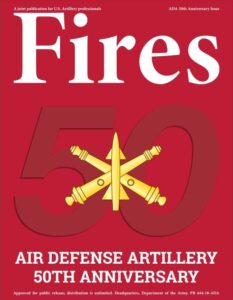
Joe Belardo was in the middle of the fight as the driver of Duster C131 that was providing convoy security. His accounts of that day are recorded in his excellent book titled “Dusterman.” It is a story of the last great gunfighters and is based on transcripts from his Vietnam diary and memoirs. As of writing this scrapbook, Belardo’s 2010 book is still available on Amazon. He and many others performed heroically that day. Their hand-to-hand fighting was thrust upon them by a savage enemy intent upon overrunning their positions at any cost. Joe was awarded a Bronze Star for Valor because of his actions that day.
Captain Tedesco’s actions are described in Chapter 9: Rescue From Dong Ha
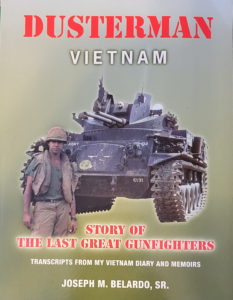
Source – Military Times Hall of Valor
The President of the United States of America, authorized by Act of Congress, July 8, 1918 (amended by act of July 25, 1963), takes pleasure in presenting the Silver Star to Captain (Artillery) Vincent J. Tedesco, Jr. (ASN: OF-101185), United States Army, for gallantry in action while engaged in military operations involving conflict with an armed hostile force, while serving with the 1st Battalion (Automatic Weapons) (Self Propelled), 44th Artillery Regiment, 108th Artillery Group, in the Republic of Vietnam. Captain Tedesco distinguished himself by exceptionally valorous actions on 24 January 1968, as Commander of a Battalion Reaction Force dispatched to relieve an ambushed convoy near Camp J. J. Carroll. When he arrived at the scene of the battle, Captain Tedesco found that the savage enemy fire had inflicted many casualties on the convoy’s troops, including all the officers. Immediately taking charge of the situation, he moved throughout the ambush site, heedless of withering hostile fire, and organized the remaining men into a highly effective fighting force. Shouting words of encouragement, Captain Tedesco directed devastating machine gun and cannon fire on the enemy positions. He then helped administer first aid to the casualties and quickly organized a detail to move the more seriously wounded away from the ambush area. As the enemy fusillade intensified, Captain Tedesco returned to the midst of the raging battle and continued to inspire his troops’ fierce fighting. His fearless and determined leadership in the face of a numerically superior hostile force enabled his men to overcome the enemy’s heavy fire, break contact and extract the ambushed convoy. Captain Tedesco’s gallantry in action was in keeping with the highest traditions of the military service and reflects great credit upon himself, his unit, and the United States Army.
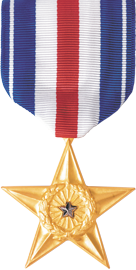
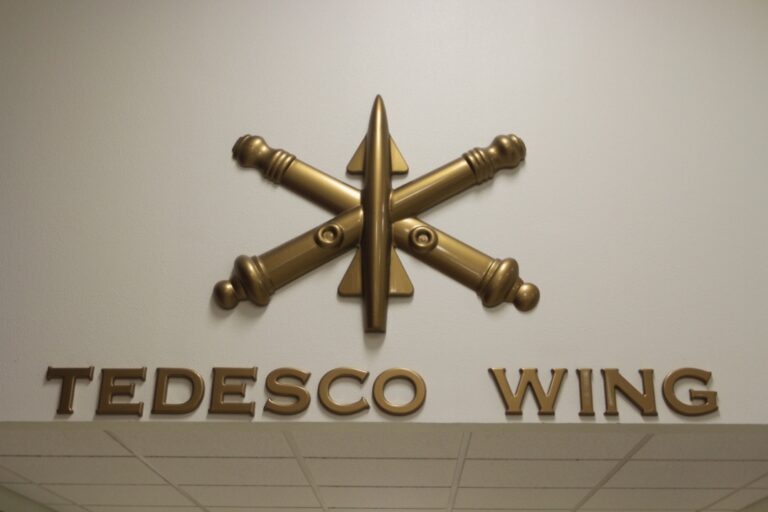
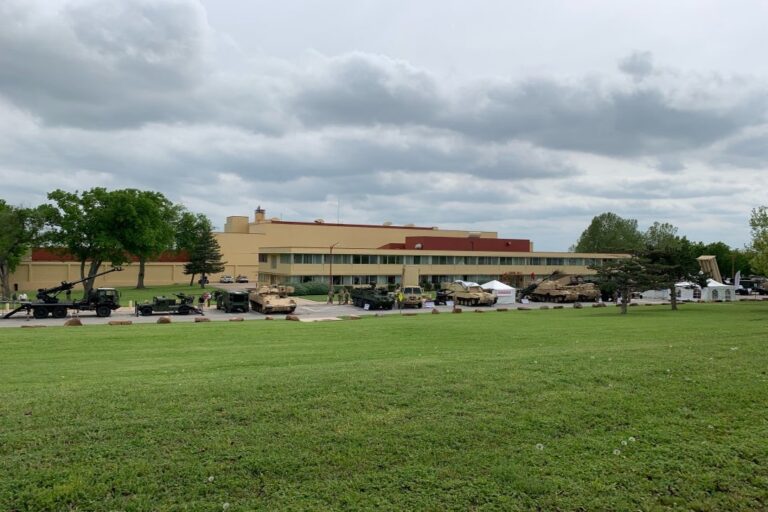
Fort Sill rebalances branch representation
By Ms. Marie Berberea (TRADOC)March 2, 2015
Article extract
Snow Hall, one of the buildings where many air defenders pass through for training, is also showcasing more ADA history with a western hall designated as Tedesco Wing as of last week.
Named after Vincent Tedesco, who retired after 27 years of service, he commanded thousands of Soldiers. He was awarded the Silver Star for gallantry in action, the Bronze Star, and the Vietnamese Cross of Gallantry with Silver Star for his service in Vietnam. He is the honorary colonel of the 44th Air Defense Artillery Regiment.
Link to 2015 US Army Article
https://www.army.mil/article/143523/fort_sill_rebalances_branch_representation
NDQSA Archived copy of article
http://ndqsa.com/wp-content/uploads/2025/01/Fort-Sill-rebalances-branch-representation.pdf
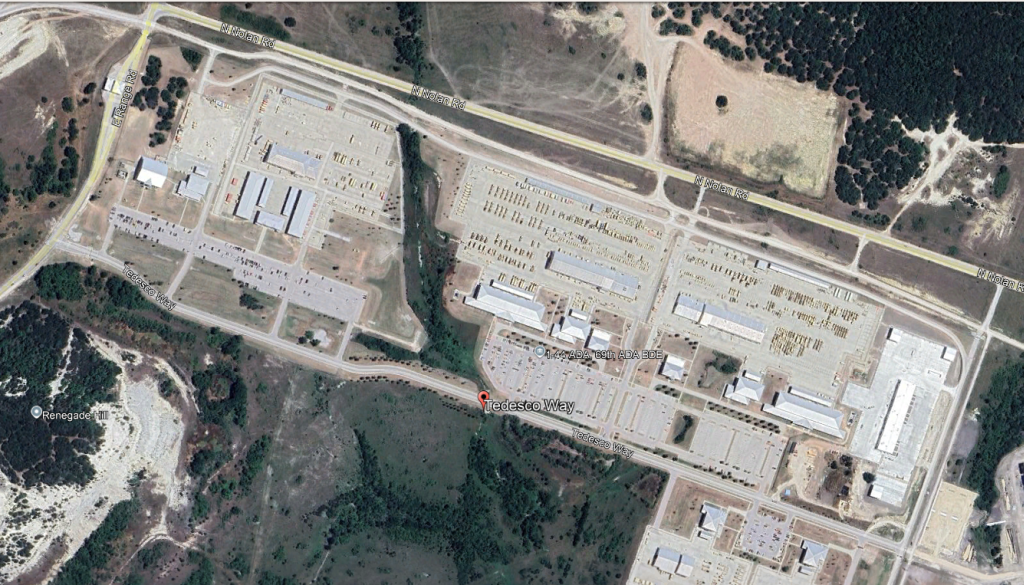
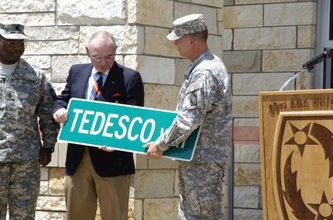
ADA receives Army standard in new brigade headquarters
Heather Graham-Ashley, Sentinel News Editor
Jul 28, 2011 Updated Dec 22, 2015
Soldiers and leadership from the 69th Air Defense Artillery Brigade officially opened their new headquarters July 21 during a ribbon-cutting ceremony. The new headquarters building is located off East Range Road and directly outside the post’s main cantonment area.
Although the building has not yet been named, during the same ceremony, the brigade re-named the street leading into the new brigade footprint “Tedesco Way,” in honor of retired Col. Vincent Tedesco, a former ADA regimental commander who was awarded a Silver Star medal for his actions in Vietnam.
When it came to naming the road, Jenkins said the brigade wanted to set the example of what is to come. He set the standard by having the road named in honor of an American hero. Calling Tedesco a “timeless leader” and a legend in the ADA community, Jenkins said, “You are our legacy and we honor you.”
Tedesco accepted the honor on behalf of his Soldiers in Vietnam, “who every day sacrificed everything they had for this country.” Regarded as a timeless leader, Tedesco said it was his Soldiers who helped him achieve what he did. “What I learned and was able to accomplish was based on what the Soldiers provided,” Tedesco said. “Take care of the Soldiers and the Soldiers will take care of you.”
The retired colonel, who began his service in June 1964, said the ADA is a great band of brothers and a constant source of pride for him. “I intend to serve the ADA until it’s over,” he said.
Link to The Army Installation news article
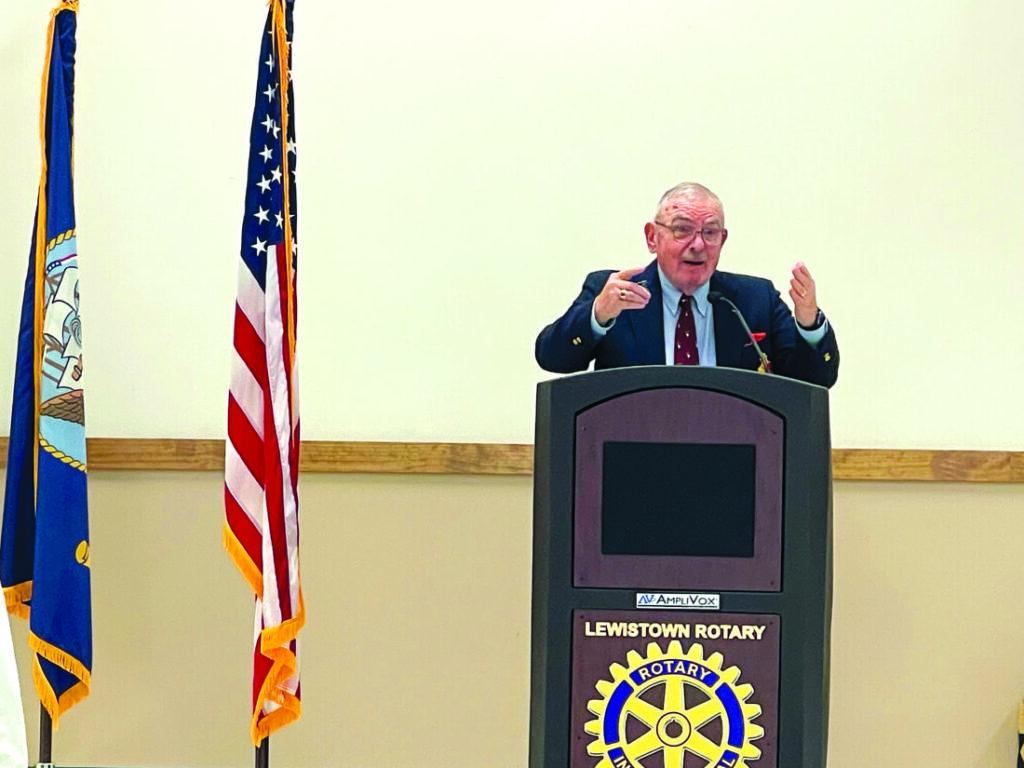
LEWISTOWN — Rotary Club of Lewistown honored veterans with their annual “Take a Veteran to Lunch” appreciation meal Friday during their weekly meeting of the club at Reedsville Fire Company. Rotary Club President William Campbell, and other Rotarians warmly welcomed keynote speaker, retired Col. Vincent J. Tedesco Jr.
EXTRACT
When first entering into Army ROTC, Tedesco was given a golden rule of thumb. “Army ROTC, first thing they taught me — 3 M’s, every part of your day: mission, men, myself; that’s the order in which you took care of things that day.
“It made my life simple. I knew exactly every day, from the day I was commissioned, what drove my life. I saw those things, I took care of the mission, I took care of my soldiers, and then, I took care of whatever I had to do. It made life easy to do it.”
Tedesco entered his time of service during the draft, which to this day remains a controversial subject for many, but instead of viewing it with disdain, he found it to be a blessing.
“All of a sudden, men were living with men that they had no idea existed … and we were forced to live together. We worked together. We had common goals. And guess what? We learned that we were all Americans … We all wanted better lives for our families. We all wanted to get on with our lives and do better and we realized that only happened when people that we didn’t know were now our brothers who were working with us to accomplish those goals.”
When reflecting on his military service, Tedesco looks back fondly on memories made.
“Fifty-five years later, I still go to my annual reunion with the guys I served with and it’s all the same. We’re brothers and we care about each other and we go through life together.
“For me, it’s been a wonderful, wonderful, wonderful experience. Whether you were in combat or not in combat, you still live with this band of brothers; there’s still men and women out there … (that) you would protect. Because you knew that they would come and protect you.”
In the closing of his speech, Tedesco gave a succinct account of his military career: “People are always saying, ‘thank you for your service’ and all that, and for me, there’s nothing to thank me for. I spent 27 years doing the best thing I could be doing in my life … those were the best years of my life. And in the 32 years since I’ve served, it’s still been beautiful. Because the friendships and the support I’ve received in those years goes on and on and on.”
Despite the tribulations faced, he remains uplifted, spearheads obstacles with grace, smiles and brings light to each day with witty banter. Among these attributes, Tedesco leaves his legacy rooted in both gratitude and honor for his service and sacrifice to this country, like millions of his fellow veterans.
“I’m a lucky guy. Eighty years of luck; the luck just goes on and on … and so many times, good things happen to you and you think they are bad things. And they turn out to be good things. Just amazing.”
And so it is.
Link to The Sentinel Article (may be a pay window)
NDQSA Archive copy

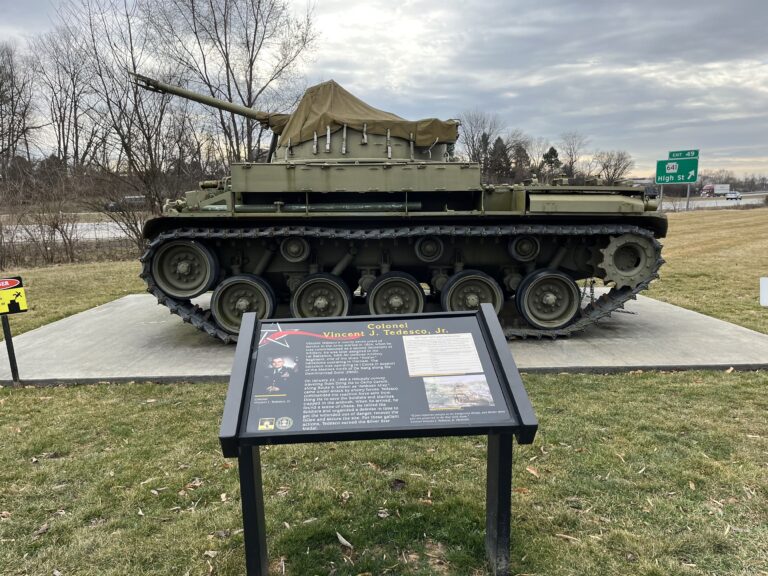
Photographed by Devry Becker Jones, February 25, 2023
Colonel Vincent J. Tedesco, Jr. Marker
Inscription.
Vincent Tedesco’s twenty seven years of service in the Army started in 1964, when he was commissioned as a second lieutenant of Artillery. He was later assigned to the 1st Battalion, 44th Air Defense Artillery Regiment, one of the three “Duster” battalions operating in Vietnam. The battalion was operating in I Corps in support of the Marines north of Da Nang along the Demilitarized Zone (DMZ).
On January 24, 1968 a resupply convoy traveling from Dong Ha to Camp Carroll, along Route 9, known as “Ambush Alley”, came under attack by enemy forces. Tedesco commanded the reaction forces sent from Dong Ha to save the Soldiers and Marines trapped in the ambush. When he arrived, he found a scene of chaos. He rallied the Soldiers and organized a defense in time to get the wounded out of danger, recover the fallen and secure the site. For these gallant actions, Tedesco earned the Silver Star Medal.
“If you expected people to do dangerous things, you better show you are prepared to do that with them.”
Colonel Vincent J. Tedesco, Jr. (Retired)
M42 “Duster” Self-Propelled Anti-Aircraft Gun
The M42 40 mm Self-Propelled Anti-Aircraft Gun, or “Duster” is an American armored light air-defense gun built for the United States Army by the tank division of the General Motors Corporation from 1952 until December 1960 and remained in service until 1988. While the M42 “Duster” was initially designed for an anti-aircraft role, it proved highly effective against unarmored ground forces in the Vietnam War.
Main Armament/Secondary Armament: Two M2A1 40 mm Bofors Anti-Aircraft Guns with 336 rounds and One M1919A4 7.62 mm Machine Gun and later with a 7.62mm M60 Machine Gun as a secondary weapon.
Engine: 500 horsepower Air Cooled Continental AOS-895-3 or Fuel-Injected AOSI-895-5k 6-Cylinder Supercharged Gasoline engine.
Maximum Speed: 45 mph
Weight: 49,500 lbs.
Length: 19.08 ft.
Height: 9.38 ft.
Width: 10.69 ft.
Crew: Six -Commander, Gunner, Sight Setter, two Loaders and Driver
Erected by The United States Army War College; United States Army Heritage and Education Center.
Colonel Vincent J. Tedesco, Jr. Marker is near Carlisle, Pennsylvania, in Cumberland County. It is in Middlesex Township. It can be reached from Army Heritage Drive south of Soldiers Drive, on the right when traveling south. Marker is at or near this postal address: 180 Army Heritage Dr, Carlisle PA 17013, United States of America. Location. 40° 12.31′ N, 77° 9.441′
Link to citation and information
The ROTC Hall of Fame was established in 2016 as part of the ROTC Centennial celebration. The Hall of Fame honors graduates of the Army Reserve Officers’ Training Corps who have distinguished themselves in military or civilian pursuits. It provides a prestigious and tangible means of recognizing and honoring Army ROTC Alumni who have made lasting, significant contributions to the Nation, the Army and the history and traditions of the Army ROTC Program.
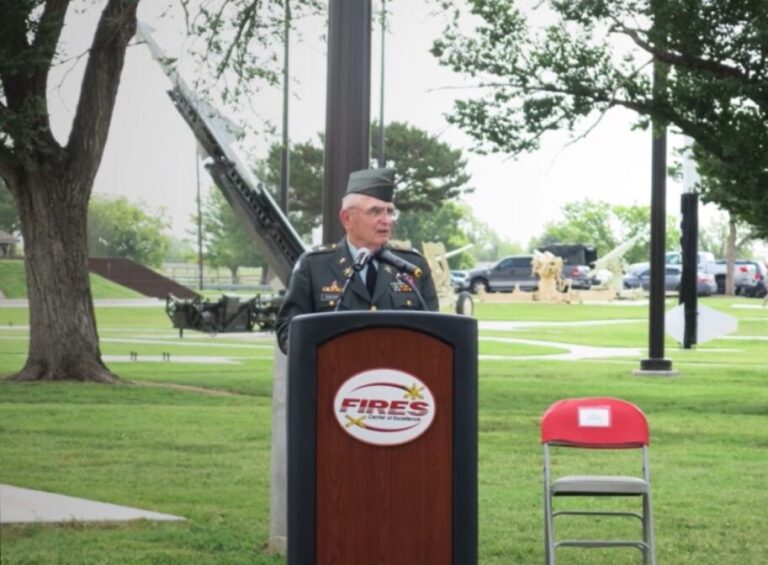
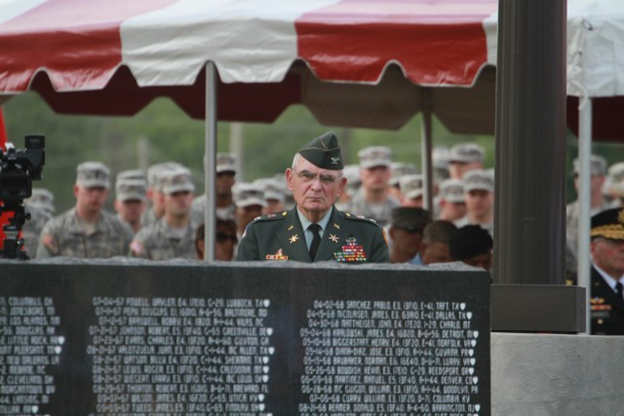
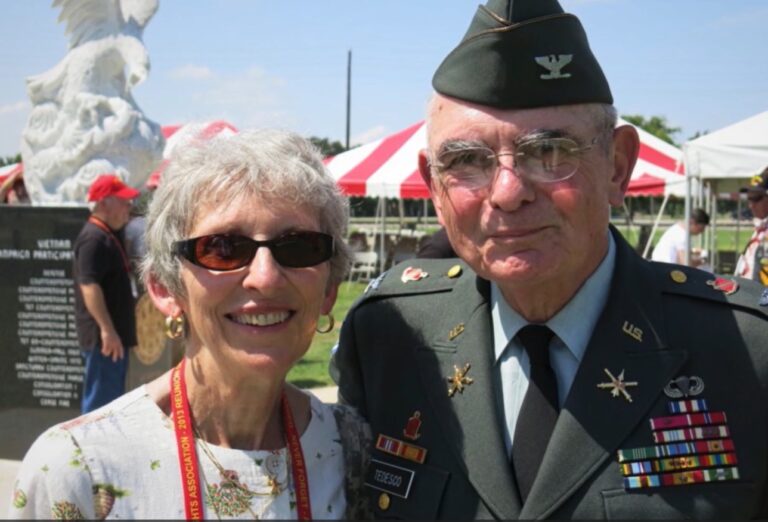
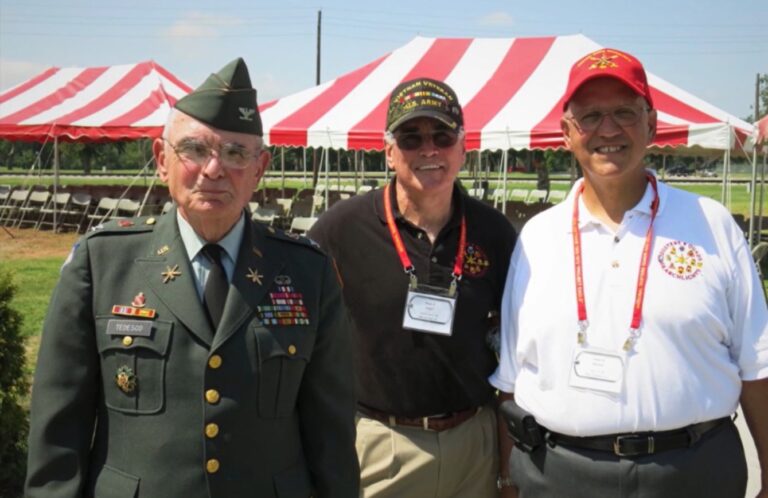
By Marie Berberea, Fort Sill, Oklahoma
August 15, 2013
Fort Sill, Okla. (Aug. 15, 2013) — The National Dusters, Quads and Searchlight Association donated a memorial to Fort Sill’s Constitution Park, during an unveiling ceremony Aug. 9.
Retired Col. Vincent Tedesco stood before a crowd of his peers and predecessors, and described what it was like to fight as an air defender in Vietnam.
“Bravery was just so commonplace it was amazing,” said Tedesco. “When you look at those guys over there now with the beards and the bellies and having trouble walking, try to go back 45 years. They were lean, mean fighting machines. Most of them drafted. They did not ask to fight in this most unpopular war, but they knew their country had called them to service, and it was their duty to serve.”
Maj. Gen. Mark McDonald, Fires Center of Excellence and Fort Sill commanding general, explained to the audience how the air defenders were so effective at shutting down the sky to the enemy that they were actually called upon to defend against the enemy on the ground, becoming a close combat asset.
“When the enemy pressed their attack at night, the Dusters, the Quads, and particularly the Searchlights, were the prime target of their attack,” said McDonald. “Events like today have set the record straight of the fantastic service that you gave your country at a very difficult time. You’re the heroes of our nation and we thank you.”
MEMORIAL DEDICATION
The memorial includes a statue of an eagle, six benches representing the five battalions and others in theater, and a slab with the 209 fallen air defenders’ names on it. The memorial planning was called “Operation Eagle,” which was set in motion in March 2011, when the National Dusters, Quads and Searchlight Association sponsored three Gold Star mothers on a trip to the place where their sons were killed in Vietnam.
Luke Clark bought the 6-foot marble eagle during that trip as an intended water feature for his home in Louisiana, but his wife, suggested other purposes. The two decided to donate it to the association as part of a memorial to the fallen Air Defense Artillery Soldiers.
“We wanted for a number of years very much to build a memorial for our fallen brothers,” said Tedesco. “Then we raised $70,000. A whole bunch of Lawton and Fort Sill people went out of their way to make it happen.”
McDonald, other post leaders, and members of the National Dusters, Quads and Searchlight Association, unveiled the statue and slab during the ceremony. As several readers came up and recited the names of each fallen air defender, Tedesco stared at the black slate. When one name was read, he saluted.
“There’s a Soldier named Strickland who’s on that wall,” said Tedesco. “He’s dead because I did not do my job properly. And I will remember Billy Strickland forever. I should have deployed my forces better. And as a result of learning my job, Billy Strickland paid the price. So Billy Strickland has a special meaning for me and I have to salute his name. I’ve told his family and begged their forgiveness, and they’ve given it to me.”
Link to Army article: Vietnam veteran air defenders donate memorial
https://www.army.mil/article/109366/vietnam_veteran_air_defenders_donate_memorial
Archived copy of Army article: Vietnam veteran air defenders donate memorial
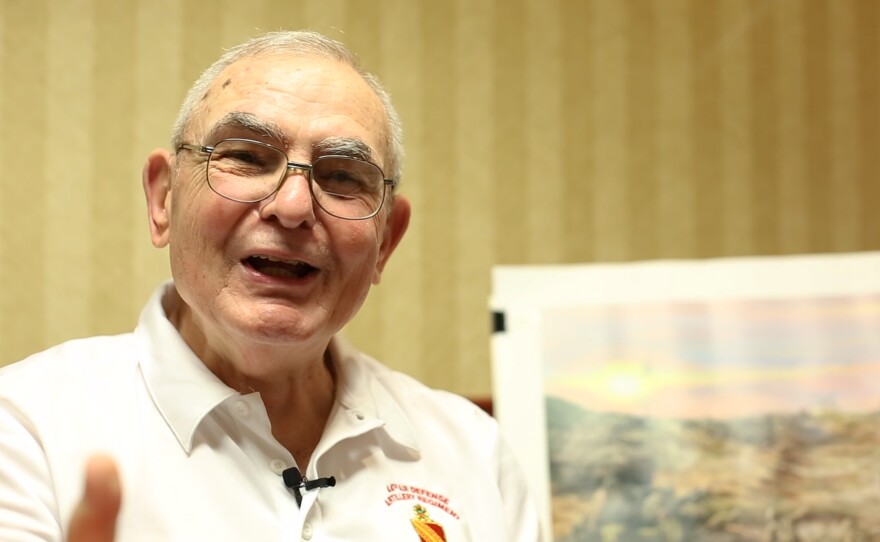
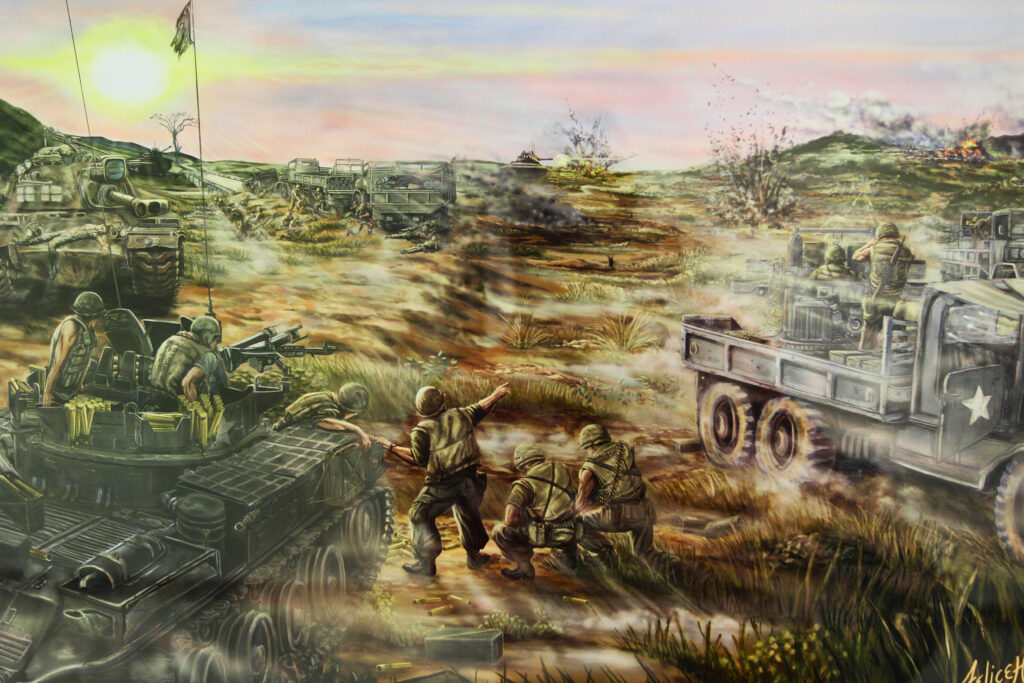
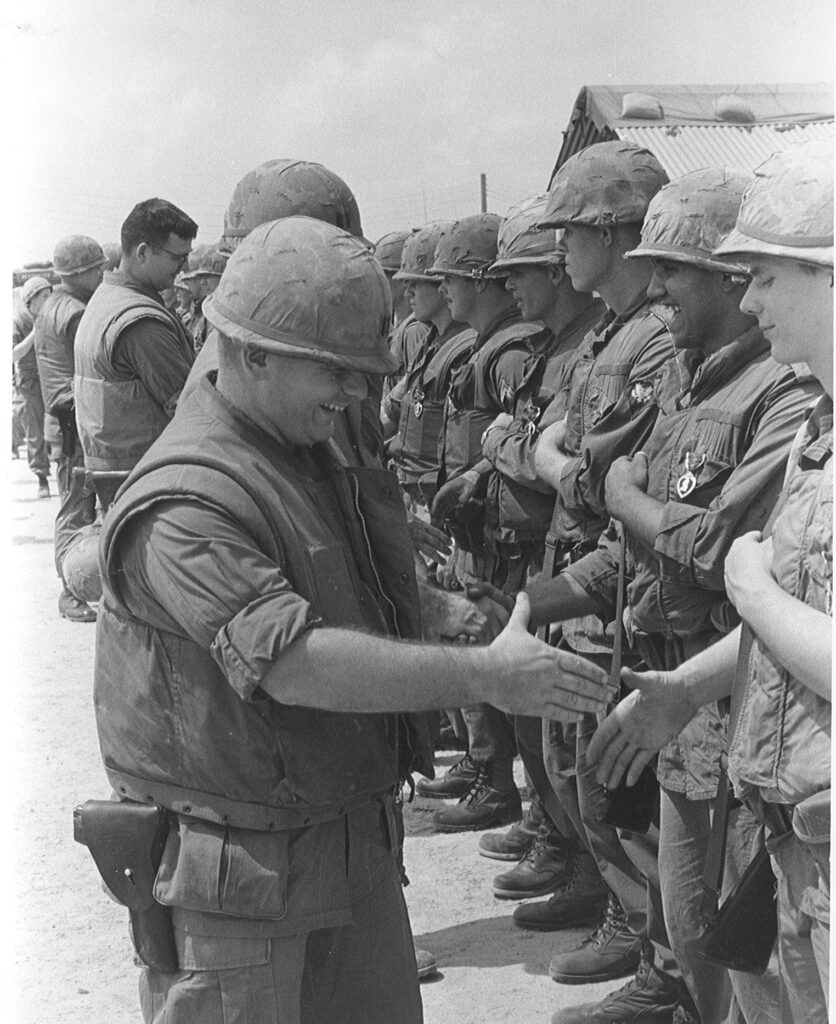
WPSU | By Min Xian
Published January 25, 2018 at 3:51 PM EST
A group of Vietnam Veterans gathered on Wednesday in State College to celebrate the 50th anniversary of “The Ambush of Route 9,” which took place on January 24, 1968.
The battle marked the beginning of a series of fights in South Vietnam and was depicted in a memorial painting. The original painting in Fort Sill, Oklahoma is 8 feet by 10 feet.
Picture on the left is a photo of the painting, Ambush on Route 9. Vince Tedesco is standing in the foreground directing M42 Duster fire on the advancing NVA. Bottom picture is of Captain Tedesco presenting purple hearts to his men after the battle.
Facebook saved video of the NDQSA gathering
A group of Vietnam Veterans gathered today in State College to celebrate the 50th anniversary of “The Ambush of Route 9,” which took place on January 24, 1968. The battle marked the beginning of a series of fights in South Vietnam and was depicted in a memorial painting. The original painting in Fort Sill, Oklahoma is 8 feet by 10 feet.
https://www.facebook.com/watch/?ref=embed_video&v=10155984314748490
An audio clip of Vince Tedesco talking at the NDQSA gathering to the reporter is archived.
“Every minute you spend with these guys is priceless. How can you not love being amongst them. You see them as they were. You start laughing to see them as they are. But more than anything else, you’re happy to see them and to once again share that brotherhood that will never go away.”
http://ndqsa.com/wp-content/uploads/2025/01/Tedesco-2-min-interview-50-anniv-20240824045418.wav
A video clip of Vince Tedesco talking at the NDQSA gathering to the WPSU reporter is archived.
http://ndqsa.com/wp-content/uploads/2025/01/TET-reunion-TV-tape.mp4
Picture left is the original picture from the Purple Heart ceremony. It was given to Joe Belardo (and shared here) by CPT Tedesco in acknowledgement of Joe’s actions on January 24, 1968 and regrets that he had been unable to get Joe a valor award for his heroism that day. Years later Vince was able to assist Joe and others in getting the medals they deserved.
Captain Vincent Tedesco is the officer on the left with his hand extended standing in front of the line of soldiers getting their medals. Joe Belardo is the second soldier from the right wearing the Purple Heart that CPT Tedesco had just pinned on his chest. There were between 30-40 men that day getting Purple Hearts from the January 24, 1968 and February 2nd battles. Also in the line were Earl Holt, John “Tank” Huelsenbeck and Vincent DeSantis.

During the 2022 NDQSA reunion in Oklahoma City, Oklahoma a special night out at the Chickasaw Bricktown Ballpark was scheduled. This is the home of the the Oklahoma City Comets, a Minor League Baseball team of the Pacific Coast League and the Triple-A affiliate of the Los Angeles Dodgers.
Arrangements were made for Vince Tedesco to make the opening pitch to Lieutenant Colonel Alex Corby, Commander of the 4th Battalion/60th Air Defense Artillery Regiment. Vince brought out a surprise and made it a fun night for the fans because he used his Lacrosse stick to make a perfect throw to Alex at home plate. It was a great night of soldier camaraderie because the Fort Sill Morale Support provided game tickets for 4/60th soldiers. The Ole Timers and young soldiers bonded throughout the evening, just like Vince and Alex planned.
Vince and Suzann have been instrumental in identifying worthy and eligible candidates for the Honorable Order of Saint Barbara and the Artillery Order of Molly Pitcher, presenting them to the NDQSA board of directors for approval, and obtaining the award certificates and medals. This entails working with the U.S. Air Defense Artillery Association (ADAA) and sometimes the Commandant of the Air Defense School at Fort Sill, Oklahoma to weave the bureaucracy to get these men and women recognized for long ago accomplishments that helped justify why there needed to be a separate branch for Air Defense Artillery.
The Order of Saint Barbara is a military honor society of the US for Field Artillery and Air Defense Artillery. The award is named for Saint Barbara, the patron saint of artillerymen. The Honorable Order of Saint Barbara is awarded to those individuals who have demonstrated the highest standards of integrity and moral character, displayed an outstanding degree of professional competence, served the Artillery with selflessness; and contributed to the promotion of the Artillery branch.
The Artillery Order of Molly Pitcher is bestowed to recognize military spouses who have voluntarily contributed in a significant way to the improvement of the U.S. Field Artillery or Air Defense Artillery Communities.
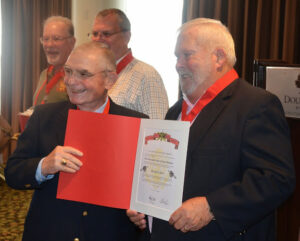
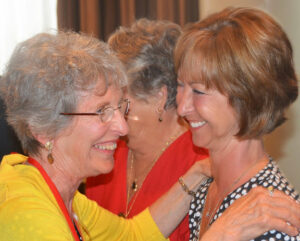
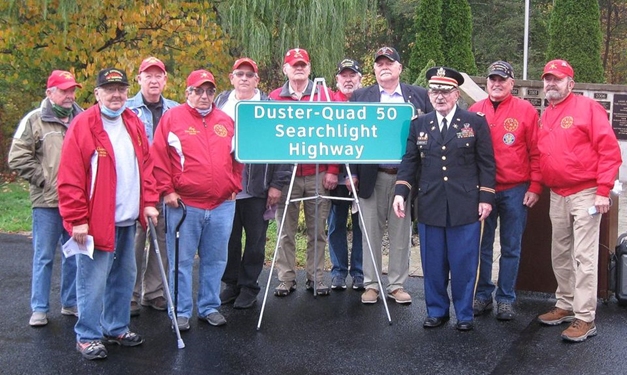
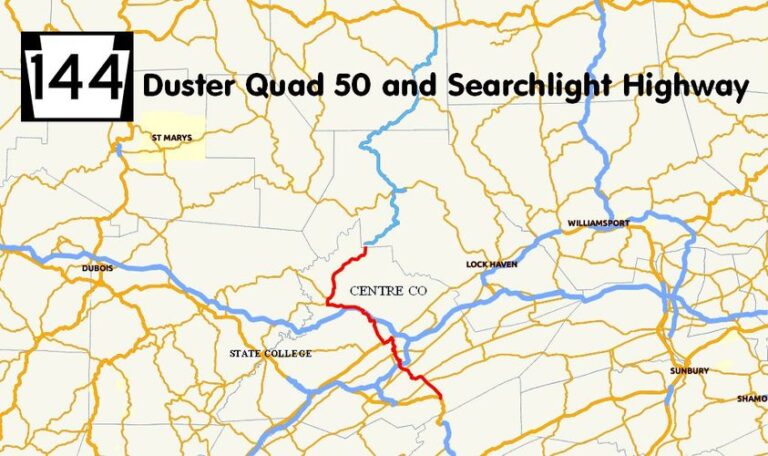

Vince Tedesco went to the Pennsylvania State Legislature and was able to get them to name a portion of Pennsylvania Route 144, beginning at the intersection of Pennsylvania Route 26 in Pleasant Gap and ending at the intersection of Pennsylvania Route 45 in Centre Hall, Centre County, designated as the Duster-Quad 50-Searchlight Highway.
Top picture: Members of NDQSA visit the location on October 28, 2020 for a renaming ceremony. Honor guard was provided by the Penn State ROTC.
Middle picture: Pennsylvania map showing the designated section of highway.
Bottom picture: Duster – Quad 50 – Searchlight Highway sign
On Wednesday, 28 October 2020, The American Legion Post 867 in Pleasant Gap, Centre County, Pennsylvania was the site of a renaming ceremony of the portion of State Route 144 between Route 26 in the North and State Route 45 in the South. Present for the Ceremony were representatives of PA Senate Majority Leader Jake Corman, State House Majority Leader Kerry Benninghoff, Members of the National Dusters, Quads, and Searchlights Association, Members of the Military Order of the Purple Heart, and other honored guests. The Honor Guard was provided by the Penn State ROTC.
The portion of Route 144 described was named the “Duster – Quad Fifty Searchlight Highway” in honor of the men who served on those units in Vietnam. There were 3 Battalions and various other smaller units that served in the combat zone from 1965 until 1972. Hundreds of Pennsylvanians served. The logic of Route 144 being chosen was the fact that one of the Battalions was the 1st Battalion, 44th Artillery. During the war men from these units were awarded at least 450 awards for valor including a Medal of Honor. There were over 1,000 Purple Hearts awarded for wounds received in action. 212 individuals were killed in action.
The primary speaker for the occasion was COL Vincent Tedesco (ret), a Penn State University ROTC alumnus and a resident of State College. COL Tedesco was awarded a Silver Star for Gallantry in Action. Former SGT Bob Lauver also spoke on behalf of the enlisted men. Lauver also holds the Silver Star and 2 Purple Hearts. Lauver resides in Selinsgrove, Pennsylvania.
NDQSA archived copy of the Pennsylvania State Legislature Act of Nov. 27, 2019, P.L. 703, No. 102
http://ndqsa.com/wp-content/uploads/2025/01/PA-Act-102-of-2019-Rt-144-dsg-NDQ-Hwy-27nov19.pdf
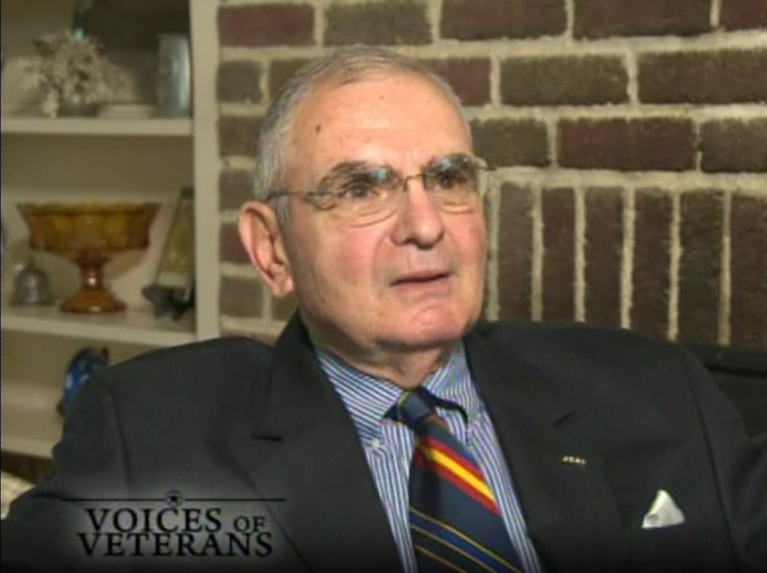
Vincent James Tedesco, Jr. Collection
Library of Congress Oral History Interview 2011
Oral History Interview 2011 Collection # AFC/2001/001/81494 1 hour 12 minutes
citation: Tedesco Jr, V. J., Beckman, P., Risser, J. & Pennsylvania Cable Network. (1964) Vincent J. Tedesco, Jr. Collection. [Personal Narrative] Retrieved from the Library of Congress, https://www.loc.gov/item/afc2001001.81494/.
Library of Congress link: https://www.loc.gov/item/afc2001001.81494/
War or Conflict: Vietnam War, 1961-1975
Branch of Service: Army
Service Unit: 1st Battalion, 44th Air Defense Artillery Regiment; 101st Airborne Division; 6th Air Defense Artillery Brigade
Location of Service: Fort Lewis, Washington; Fort Benning, Georgia; Fort Carson, Colorado; Fort Leavenworth, Kansas; Pentagon, Arlington, Virginia; Newport, Rhode Island; Germany; Vietnam; Korea
Highest Rank: Colonel
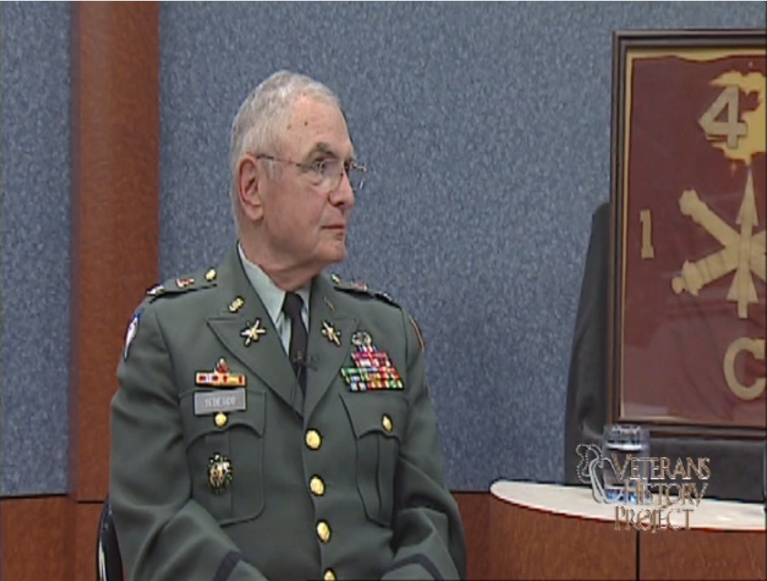
Oral History Interview 2013
Citation: Tedesco Jr., Vincent James, et al. Vincent James Tedesco, Jr. Collection. 1964. Personal Narrative. Retrieved from the Library of Congress, <www.loc.gov/item/afc2001001.88931/>.
Library of Congress link: https://www.loc.gov/item/afc2001001.88931/
Collection # AFC/ 2001/001/88931 59 minutes Oral history interview (collected 2013-04-24)
editor note: April 24, 2013 at Pennsylvania State University, College of Communications with Meghin Moore and then was included in the Veterans History Project.
Description: Colonel (Ret) Tedesco’s interview includes personal stories about his life, his time in Vietnam, and the Army of the 1960’s and 70’s. Early in the interview (minute 8) he describes the January 4-5, 1968 battle of Checkpoint 39 on route 9. Throughout the interview there are lessons for leaders, inspirational guidance, and a respect for humor at life’s vagaries. He also talks about the men of the National Dusters, Quads & Searchlights Association and the value of camaraderie. The interview is recommended for military historians, young Army leaders, and others interested in hearing the personal story of an Air Defense Artillery trailblazer.
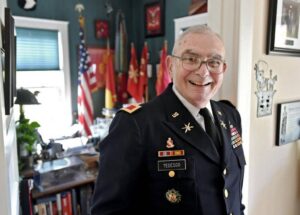
Central Daily Times
September 04, 2016
When in doubt, just follow the leader.
Conventional wisdom aside, it helps to know that the person at the front of the line (and on the front line) has a proven track record — and that definitely applies in the case of retired U.S. Army Colonel Vincent Tedesco of State College. After leading a reaction force against an enemy attack during the Battle of Dong Ha in South Vietnam, Tedesco was awarded the Silver Star Award for leadership.
Q: How old were you when you joined the Army?
A: I was commissioned upon graduation from Penn State ROTC at the age of 21.
Q: Did you feel a calling?
A: Yes, by the beginning of my senior year at State I knew I wanted to be a professional soldier. Growing up on Long Island, that was my dream.
Q: How long were you in Vietnam?
A: I served in Vietnam for a year, 1967-68.
Q: Do you think that there was something that distinguished Vietnam from other wars or conflicts that the country has been involved with, at least from a military perspectives?
A: The overriding control of the strategic and operational efforts in waging the war by politicians in Washington was like fighting with one hand behind your back. This, plus the total lack of support by the media, led to the loss of the war and the wasting of 58,000-plus lives, as well as the terrible treatment given to many who served upon their return home.
Q: Who is someone that you looked up to or considered a great leader in your life?
A: I served under and with many great soldiers, but the ones who had the greatest impact upon me were Col. John House (my battalion commander in Vietnam) and Maj. Gen. Don Infante (a general I served under later in my career). Some other great leaders I was privileged to serve with and learn from were then-1st Sgt. Alex
Crawford (later he was a command sergeant major), and Command Sgt. Maj. Wayne Barefoot, who was my CSM when I commanded a battalion in the 101st Airborne Division. In fact, I was lucky to work with or command a number of great non-commissioned officers who were great leaders and taught me a great deal. I also
served under a few commanders who taught me what not to do.
Q: In your opinion, what is the most important quality for a leader to possess?
A: Take care of your soldiers and lead from the front. My first day in the Penn State ROTC, I was taught to follow the three Ms: Mission, Men and Myself. This is the order in which you expend your efforts every day. This is the single best thing I was ever taught.
Q: When did you retire? What has your life post-military looked like?
A: I retired in 1991, after 27 years. I was 48 and decided I should make some money before I got too old. I was then a director in the Lockheed Martin Corp. until I retired again in 2011. I have been invited to teach leadership at the Army’s Air Defense Artillery School at Fort Sill, Okla. I am on the board of directors of the Air Defense
Artillery Association, president of the Central Pennsylvania Chapter of the Military Officers Association of America, was the adviser to my fraternity for over 20 years and coached lacrosse at State College (Area) High School for five years. I also volunteer with the Penn State men’s lacrosse team. I teach and serve on a committee for the Penn state Osher Lifelong Learning Institute (OLLI) program, a service of Penn State Outreach that offers community members the opportunity to learn, explore, and connect through education and social enrichment.
Q: What do you hope that people take away from your lecture at the military museum?
A: I hope people learn about the great young men who served their country. I hope they learn the lessons I learned: heroes come in all sizes, shapes, races, religions and sexes. Americans come in all sizes, shapes, races, religions and sexes and we fight and die as Americans. … What I really want to leave in the minds of those who attend my talk is a question. Why are American fighting men and women able to defeat the best in the world on the battlefield, time and time again? Think about it, from 1783 to today, no nation can beat us on the battle field. The only one that came close was the South in the Civil War – Americans against Americans who were fighting for a corrupt idea.
Q: Why do you think that it’s important for the stories of soldiers on the front line to continue to be told?
A: Now more than ever before, with such a small percentage of Americans serving, people must be made to understand how terrible combat is for those who fight. They must understand that sending young men and women into combat is something that should only be done for the most important reasons. Those who have served should never again be treated the way my men were when they returned from doing their duty.
Link to Central Daily Times article (may be behind pay window)
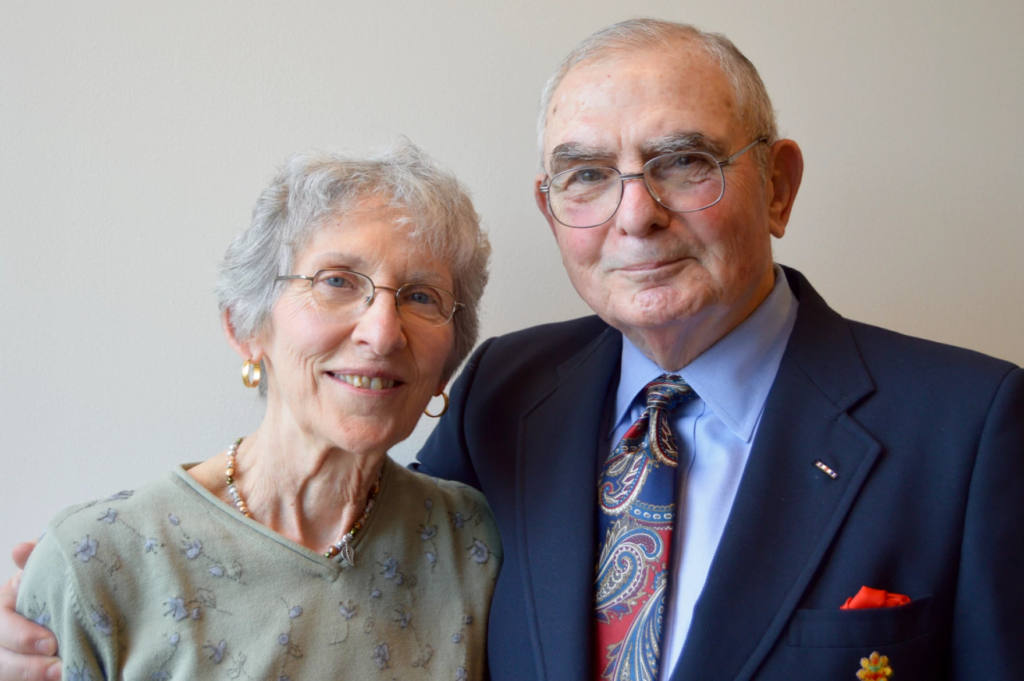
WPSU by Emily Reddy Published October 9, 2017
Transcript
Emily Reddy WPSU News Director
You’re listening to W PSU Story Corps as a part of WPSUS radio, TV and web project, the Vietnam War – The Pennsylvania story. We’re bringing you oral history interviews with Vietnam Veterans. Today, Suzanne Tedesco talks with her husband, Colonel Vincent Tedesco, about leading men in Vietnam.
Suzanne Tedesco
In spite of being told that you were not going to get a battery command, you eventually did. And you took command of Charlie Battery. How did that work out and what were the challenges you faced in terms of personnel and being on the road all the time?
Vincent Tedesco
Commanding Charlie Battery was one of the most wonderful experiences I’ve had in my life. I had about one hundred and fifty men with sixteen Dusters and I was spread from the middle of Vietnam to Khe Sanh. Let’s talk about the men. My men were predominantly draftees. Some of my men were what we called McNamara’s 100,000. For those who don’t know about McNamara’s 100,000. Robert McNamara, the Secretary of Defense, who was a jerk in many ways, had chosen not to activate the Reserve and the National Guard. That required him to draft a heck of a lot of young men. And he was starting to run out of the pool of those that could be drafted. So, what he did was he lowered the standard of who could be drafted. But that wasn’t enough. He gave these poor guys different serial numbers so that every one of us knew that these guys were not as smart as the guy next to them. And it was a terrible, terrible stigma to apply. But let me tell you, my McNamara 100,000 guys were just as brave, just as hard fighting, just as wonderful as any other American soldier I ever saw. Okay. Our guys realized that Americans were black or white or Hispanic, were Catholics or Protestants or Jews, were tall or short, were skinny or fat. Those are all Americans. Our enemies did not say, “Well, today I’m only going to shoot a white American and a Jewish American and a short fat American.” We were all Americans, and my guys acted like that. They were the bravest guys in the world.
Suzanne Tedesco
Can you sort of sum up what you learned from your time in Vietnam?
Vincent Tedesco
I learned a lot. I learned to lead. I learned you can’t know whether a person is going to perform under combat and pressure by looks. There’s no way. You have no idea who’s going to be brave, and who’s going to be a chicken. You don’t know who’s going to stand up and do a job until they’re tested. Okay. I learned that Americans are just wonderful, wonderful men. And my time in Vietnam could not have been better.
Emily Reddy WPSU News Director
Suzanne Tedesco talks with her husband Vincent Tedesco, the 10-part documentary, The Vietnam War by Ken Burns, is currently airing on. W PSU TV. The WPSU documentary, “A Time to Heal” on the Vietnam War experience from a Pennsylvania perspective, airs November 12th at noon. With WPSU Story Corps I am Emily Reddy.
Link to interview on WPSU
Audio Archive of their interview
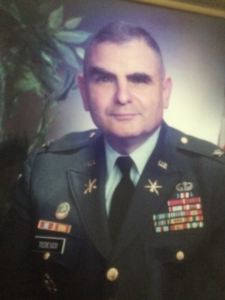
Vincent J. Tedesco, Jr., was born in Jamaica, NY in 1943. His parents were Vincent James Tedesco, Sr. and Angela Agnes (Letterelo) Tedesco. Vincent, Sr. came to the United States in February 1921. Vincent, Jr. had one brother, Michael Thomas Tedesco.
He graduated from the Pennsylvania State University and was commissioned a second lieutenant of Artillery in the Regular Army in 1964. While at Penn State he was co-captain of the lacrosse team and a member of Delta Upsilon Fraternity. He was the starting goalie. He was selected as one of the outstanding freshmen athletes and was All League and All Conference. He and three high school lacrosse teammates established the “Friendship Cup” which is presented each year to the winner of the lacrosse game between Penn State and Rutgers. He later earned a master’s degree in business administration from Bucknell University in 1972 and is a graduate of the Army Command and General Staff College and the Naval War College.
Upon graduation from Penn State, Tedesco was commissioned a second lieutenant of artillery in the Regular Army. He served a 1967-68 tour of duty in Vietnam, which included the 1968 Tet Offensive. For gallantry in combat, he was awarded a Silver Star, a Bronze Star, and the Vietnamese Cross of Gallantry with Silver Star. His Silver Star was earned as a young Captain in Vietnam on January 24, 1968 when his reaction force relieved an ambushed convoy below Camp J.J. Carroll on Route 9. He was cited for determined leadership and courage under fire from a numerically superior force which turned the tide of the battle and resulted in the extraction of the wounded and ambushed column. In July 1968, he was Commander of Charlie Company, 1st Battalion. 44th Artillery when they were part of the forces that relieved the surrounded Americans on Khe Sanh, which was a 77-day siege and one of the longest and bloodiest battles of the Vietnam War.
Tedesco retired from the Army in 1991 at the senior field grade of colonel. During his 27 years of military service he commanded 3 batteries, the 1st Battalion 3rd Air Defense Artillery, 101st Airborne Division and the 6th Air Defense Artillery Brigade. During his military service, Tedesco also received the Legion of Merit Medal with two Oak Leaf Clusters for exceptionally meritorious conduct in the performance of outstanding service; the Defense Meritorious Service Medal for outstanding non-combat achievement; the Meritorious Service Medal with four Oak Leaf Clusters; the Army Commendation Medal; and the Joint Service Achievement Medal.
After his retirement, the Army honored him by making him the Honorary Colonel of the 44th Air Defense Artillery Regiment. He has also received a number of honors: the rare honors of having a street, Tedesco Way, at Fort Hood Texas named for him; the leadership award for lieutenants at the Air Defense Artillery School is named in his honor; a picture was painted of the fight he led in Vietnam and a wing in Snow Hall, the home of the Air Defense Artillery and Field Artillery, has been named Tedesco Wing! The Penn State Army ROTC Battalion honored him by making him the Honorary Colonel of the Nittany Lion Battalion. He retired from Lockheed Martin in 2011. While working for Lockheed Martin, he was awarded the Washington Award 6 times, the Washington Community Service Award and in 2005 the highest award that can be given to a Lockheed Martin employee, the Nova Award.
Vincent Tedesco is a lifetime member of the National Dusters, Quads & Searchlights Association, Inc. and serves on their board of directors as a senior advisor. He also serves on the boards of directors of the Air Defense Artillery Association and the Penn State Chapter of Delta Upsilon Fraternity. He was a volunteer coach with the State College High School’s lacrosse team, and often speaks about leadership to young officers attending classes at the Army’s Air Defense Artillery School at Fort Sill, Okla.
He and his wife, the former Suzann Andrews, also a 1964 Penn State graduate, were married shortly after graduation. They have three children: retired Army Col.(Ret) Vincent J. Tedesco III (Penn State ’86); Army Col.(Ret) Matthew T. Tedesco (Penn State ’91); and Mrs. Kim Tedesco Riley. Their eldest granddaughter Rachel is a Penn State alumni. Tedesco is a life member of the Penn State Alumni Association, a long-time member of the Nittany Lion Club, and a financial supporter of the university at the President’s Club level. He and his wife also support a number of Penn State educational and athletic programs.
Tedesco has actively supported Penn State Army ROTC for over 30 years, attending every formal and social event, serving as a personal mentor to each new ADA officer, delivering countless commissioning remarks, and encouraging Cadets and Cadre along the way. He created and sponsored an endowed scholarship for Penn State Army ROTC Cadets and frequently supports the program during university financial development drives.
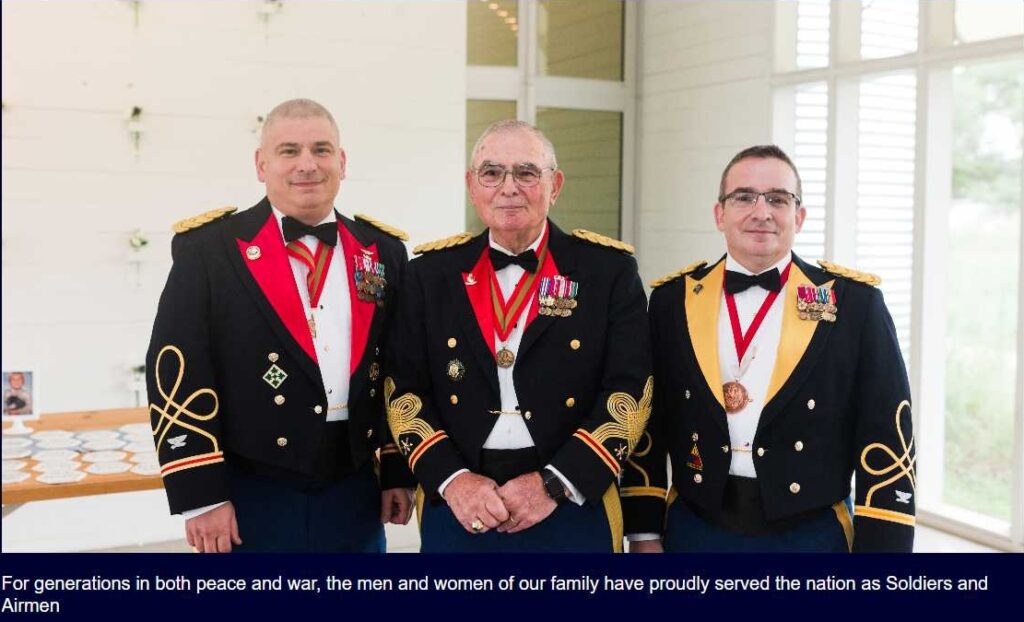
Vincent J. Tedesco Jr and his sons Matthew T. Tedesco (left) and Vincent J. Tedesco III (right) have served our nation honorably. We thank them and wish their families well.
